


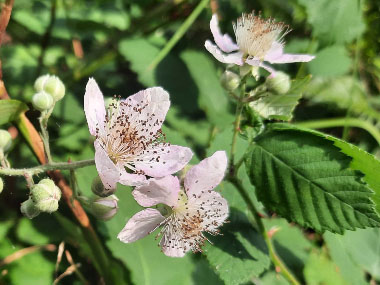

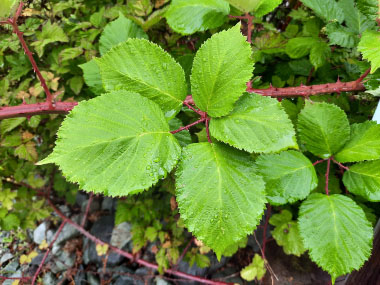
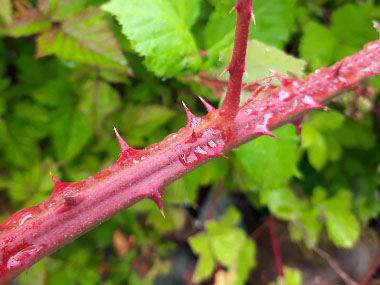
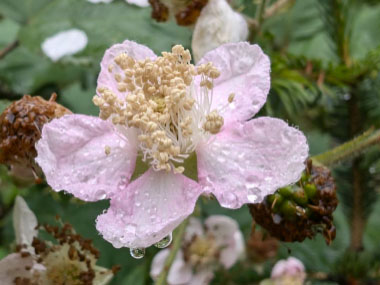
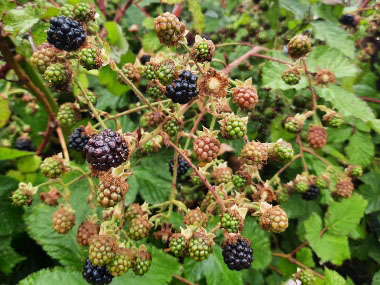
To support our efforts please browse our store (books with medicinal info, etc.).
Himalayan blackberry is an invasive bramble species that dominates many open areas in several parts of the world. This shrub produces huge quantities of berries. It is a perennial woody shrub in which individual canes can spread to impressive lengths. Blackberries are in the Rosaceae (rose) family. The Rubus genus is large and very complex consisting of more than 750 species worldwide. They reproduce primarily vegetatively from their rhizomes and root crown. They also reproduce from seed, which aids establishment on new sites, including burn sites. Animals primarily disperse seeds. Interestingly, the seeds have a hard coat, are dormant upon dispersal, and are stored in the soil. Fire or animal ingestion helps break seed dormancy. This is a broadleaf evergreen shrub. This shrub grows quite tall, has erect branches, then arching, trailing, and may root where branch nodes contact the soil.
Trunk/Bark
There is no main trunk.
Branches/Twigs
Branches are referred to as canes. Canes are sharply angular, glabrous, dark purplish to reddish, and densely covered with stout thorns. Canes can grow to a length of over 6 metres (20') in a single season. Branches are biennial, in the first year they are sterile, called primocanes, producing leaves but no flowers. In the second year lateral branches, called floricanes, arise from axils of primocanes and produce both leaves and flowers.
Height
This shrub grows to 3 metres (10') high, erect branches, then arching, trailing, may root where branch nodes contact the soil, sprawling to form large, dense, impenetrable thickets.
Leaves/Needles
Leaves are toothed and typically compounded with five leaflets but atypically or on fruiting branches, can be tri- or unifoliate. Leaf blades measure 3 to 12 cm (1.18 to 4.72") long and are ovate to orbicular and dark green. The leaves appear similar to black raspberries except the underside of blackberry’s leaves are lighter than their upper side, the black raspberry leaves are markedly lighter, almost whitish.
Flowers
Small clusters of flowers are white to rose colored and have five transversely arranged petals. The flowers form in groups of 3 to 20 in terminal panicles. Flowers measure about 2.5 cm (.98") wide.
Fruit
The fruit are less than 2 cm aggregates of black, shiny, roundish drupelets. Each drupe contains a single, hard, flattened seed. Berries can be susceptible to dryness or mold. The berries need rain prior to developing for a good harvest. Blackberry fruit pulls away from the plant, leaving a flat-like receptacle. The black raspberry fruit pulls away leaving a sizable cone-shaped receptacle.
Habitat
This species of blackberries are found on disturbed sites, roadsides, parklands, pastures, streambanks, forest edges and in cultivated areas. They prefer rich, well-drained soils but they thrive in a variety of soil types. Himalayan blackberries are present in many countries and is considered native only to Armenia and possibly also northern Iran. It has become widely cultivated and naturalized in many parts of the world.
Edible Parts
Ripe berries are very tasty. They are excellent as is, in jams and baked goods, juices, or fermentation. This shrub has vicious thorns that can easily rip into the skin so using extreme caution while foraging is paramount.
Other Name
Blackberries.
Recipes
Winter Survival Food Handbook

PDF Plant Magazines
Types of Wild Food
Geographic Zones Seasons
Disclaimer
EdibleWildFood.com is informational in nature. While we strive to be 100% accurate, it is solely up to the reader to ensure proper plant identification. Some wild plants are poisonous or can have serious adverse health effects.
We are not health professionals, medical doctors, nor are we nutritionists. It is up to the reader to verify nutritional information and health benefits with qualified professionals for all edible plants listed in this web site. Please click here for more information.
Why Edible Wild Food?
- Food costs are rising
- Free, wild food is readily abundant
- Wild food adds nutrition to your diet
- Wild food can help treat various medical conditions





